






February 2025 | Issue 204
2 1 3 4 5
It takes a community to farm successfully and wheat producers across the country are fortunate to have the National Association of Wheat Growers (NAWG) in their corner, focusing on the policies that affect the livelihoods of U.S. wheat producers. Don’t miss pages 10, 11 and 12 to learn more about NAWG’s winter meeting and Capitol Hill visits.
PUBLISHER AND CIRCULATION
Minnesota Association of Wheat Growers
2600 Wheat Drive • Red Lake Falls, MN 56750
218.253.4311 • Email: mnwheat@mnwheat.com Web: www.mnwheat.org
EDITORIAL
Doug Monson, Sr. Director of Integrated Marketing
Ag Management Solutions
1020 Innovation Lane • Mankato, MN 56001
Ph. 507.995.7534
Email: dmonson@agmgmtsolutions.com
Sydney Harris, Managing Editor
Ag Management Solutions
Ph: 218.689.5091
Email: sharris@agmgmtsolutions.com
CONTENT
EDITORS
Drew Lyon, News Editor
Ag Management Solutions
Ph: 507.388.1635
Email: dlyon@agmgmtsolutions.com
Katelyn Engquist
Ag Management Solutions
Ph: 507.508.1540
Email: kengquist@agmgmtsolutions.com
ART DIRECTOR
Alex Troska
Ag Management Solutions
Ph: 952.334.2539
Email: atroska@agmgmtsolutions.com
ADVERTISING SALES
Erin Rossow, Ag Management Solutions
Ph: 507.902.9191
Email: erin.rossow@agmgmtsolutions.com
ABOUT PRAIRIE
Prairie Grains magazine is published six times annually and delivered free of charge to members of these grower associations, and to spring wheat and barley producers in Minnesota, North Dakota, South Dakota and Montana. To subscribe or change address, please write or call our circulation department.
06 14 16 24 26
Stepping in to give back: MAWG welcomes new directors, familiar face to board following election
Growing a network: Prairie Grains editor conquers ‘daunting’ challenge
Small grains, big updates
Checkoff benefits: Farmer-funded research is helping boost wheat’s demand
Back to the stone age: NCI’s stone milling course helps raise ancient technology

Minnesota Association of Wheat Growers and Minnesota Wheat Research & Promotion Council 2600 Wheat Drive • Red Lake Falls, MN 56750 218.253.4311 • Email: mnwheat@mnwheat.com Web: www.mnwheat.org
North Dakota Grain Growers Association 2401 46th Ave SE , Suite 204 • Mandan, ND 58554 701.222.2216 • Email: danw@ndgga.com Web: www.ndgga.com
South Dakota Wheat Growers Association 116 N. Euclid, Box 667 • Pierre, SD 58501 605.224.4418 • Email: wheatinc@midco.net


Montana Grain Growers Association P.O. Box 1165 • Great Falls, MT 59403 • 406.761.4596 Email: erobinson@mgga.org • Web: www.mgga.org
Northland Community and Technical College 1101 Highway One East • Thief River Falls, MN 56701 218.683.8800 • Email: ron.dvergsten@northlandcollege.edu Web: www.northlandcollege.edu
February 2025 | Prairie Grains | Page 3
Not that there was any doubt, but winter is in full force in Minnesota as I write this column on a frigid January morning at my home, where the wind howls and the high today is 18 degrees below zero. “Bitterly cold,” reads the forecast.
It is hard to believe in just a few months, our soil will be restored to the point where we can begin planting our 2025 crop. But this is why we live up here, Mother Nature’s cycling of the seasons.
In contrast to the weather outlook, rather than bitter, we are retaining a sense of optimism and cooperation this winter.
In mid-January, I joined Minnesota Wheat directors and staff for board meetings with the National Association of Wheat Growers (NAWG) and our partners at U.S. Wheat Associates. After holding our annual meeting at Commodity Classic every year since 2007, NAWG elected to move the 2025 annual meeting to our January gathering in Washington, D.C. By all accounts, moving our annual meeting to D.C. was a positive, both financially and logistically. We heard a few things that may bode well for wheat prices in the future.
Our time in the nation’s capital, which was just a few days before Donald Trump’s inauguration, also included a Capitol Hill visit with legislators. We met with our
congressional delegation, including Sen. Amy Klobuchar and Rep. Angie Craig, who were recently named ranking Democratic members of the Senate and House ag committees. Along with the Farm Bill, we also thanked legislators who supported an economic assistance package for farmers at the end of 2024 and discussed the need for rural health care reform. Representation is vital, and the Northern Plains has its fair share of leadership in Congress and the Trump administration, from Ag Committee membership that includes Sen. John Hoeven (R-N.D.) to South Dakota Sen. John Thune being elected Senate majority leader and former North Dakota Gov. Doug Burgum and South Dakota Gov. Kristi Noem both serving in President Trump’s Cabinet.
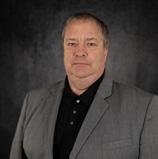
Back home in Minnesota, the Legislature is trying to work through unprecedented circumstances. Hopefully our elected officials can work together to resolve the issues so they can get to work.
Throughout our engagements with legislative leaders, we stressed the need for not just a new Farm Bill, but an improved Farm Bill. Fortunately, we talked with Ag Committee chairs Sen. John Boozman and Rep. Glenn “GT” Thompson. It really does appear both chairs have functioning working relationships with the two Minnesota ranking members. We look forward to working with all of them.
As an advocacy organization, we stay bipartisan. We focus on what we can control, and that means working with leaders from both parties and the Minnesota Department of Agriculture to implement our policy priorities and improve the farm economy. We look forward to furthering those conversations later this month when the MAWG officer team and members travel to the Capitol for our “Wheat Day on the Hill” Feb. 24-25, 2025. If you are interested in attending, time is of the essence. Call the MN Wheat office at 218-253-4311 ext. 7 to sign up. The trip is free to all active MAWG members. Help us advocate!
As you turn your attention to the spring planting season, help MAWG fight against needless regulations of the ag industry. Join MAWG by visiting mnwheat.org/growers/. You are needed!
Kevin Leiser farms in Fertile, Minnesota, and serves as president of the Minnesota Association of Wheat Growers.

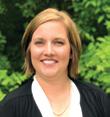
There are no guaranteed profits in farming. All we can do is control a few items, pull the trigger on others and do our best. Some years are memorable for great profits, and others we remember for the crash and burn. This winter as you meet with your lender, grain buyer, accountant and farm management instructor, have a to-do list to ensure this year is not a crash and burn. First on the to-do list is forward contracting. There is no way around it. Something must be sold in advance. It can be a small amount but get something sold ahead of harvest. Use an 18- or 24-month window to price your grain instead of selling everything post-harvest. There were sales opportunities in spring 2024 and we will likely have opportunities again this year.
Make it a goal to avoid all storage costs in 2025. If you deliver grain, it’s because that was the plan. My area had large crops in 2024, and many farmers ran out of storage. That’s a wonderful problem, but the storage costs or delayed payments fees can add up quickly. We have very tight margins in 2025 and cannot afford to spend 30
Betsy Jensen is a Farm Business Management Instructor at Northland Community and Technical College. Follow her on X at @jensenbetsyr.
cents per bushel on elevator fees. There needs to be a drop-dead date for grain sales. So many of you are still holding 2023 grain unpriced. In your bins you have 2023 and 2024 crops. Throughout 2024 you borrowed money for operating expenses while your bins were full of 2023 crop. This strategy is expensive, but your bank appreciates all the extra interest you paid. We know the market spikes but, in my experience, if you are holding grain during a spike, you are still holding it when the spike is over. I hope your wheat enjoyed the ride from $6, to $10 and back to $6. Oh, the stories it could tell.
Another area of emphasis in 2025 should be cash flow management. If I did not farm myself, I would think you farmers are horrible bookkeepers who do not understand their invoices. But I am in the same boat! Chemical A got moved to payment plan A and Seed B is due in ninety days, but Seed C can be deferred to 2026. Good grief! It is a full-time job to manage cash flow, but it is a job that can pay well. I read the fine print to find the payment amount to avoid interest expense. I have sticky notes with
payment due date reminders. Do a better job monitoring your cash flow and avoid the unexpected late fees and interest expenses. Timing grain sales to coincide with due dates would be a great fit.
Finally, if you are overwhelmed with finances, there are farm management faculty in Minnesota, North Dakota and South Dakota who can help. We cannot be shocked by anything farmfinance related. You may think you have a unique situation with no solution, but we have seen it before. The biggest concern I have is the doom loop that is playing in your head right now. We always envision the worst-case scenario, which I call the doom loop. When we put numbers on paper and create a plan, we silence the doom loop. Your brain can focus on the plan, and not the doom loop.
If you are not familiar with the doom loop, you have not been farming long enough. Every farm has bad years. Creating a plan to recover is essential. Forward contract, avoid storage costs, sell grain, work with your grain buyer and manage your cash flow. Those are some of the 2025 steps to success.
By Bailey Grubish
MAWG welcomes two new directors, familiar face to board following election
Two fresh perspectives are jumping aboard the Minnesota Association of Wheat Growers (MAWG) ship. To help guide them through the water alongside the rest of the board, a veteran MAWG director has been reelected.
Kristin Hamre and Logan Johnson are the two newest directors of the organization with Erik Younggren continuing to serve in District 1. In addition, Fertile farmer Kevin Leiser was reelected president, Austen Germolus will serve as vice president and Tate Petry returns as secretary/treasurer. The MAWG board is rounded out by Director Mike Gunderson, who served as president from 2021-23.
MAWG directors represent the entire state, which is split into two districts, with seven board members – two representing District 1; a pair representing District 2 and three at-large positions.
Farmer directors meet six times annually to discuss important policies and initiatives. Along with board meetings, directors participate in lobbying trips to St. Paul and Washington, D.C., attend the MAWG annual meeting during the Prairie Grains Conference and travel to National Association of Wheat Growers (NAWG) meetings.
MAWG comprises farmer leaders with various experiences, representing Minnesota wheat growers where it matters.
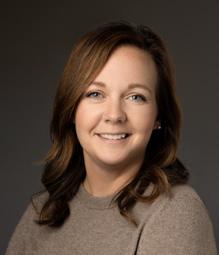
Kristin Hamre, who was voted onto the board at the Prairie Grains Conference during MAWG’s annual meeting, is looking forward to serving her fellow Minnesota wheat farmers as the newest MAWG at-large director.
“I love problem solving,” Hamre said. “After taking time during meetings to learn what is high on the list, I hope to contribute ideas to help move these ideas to reality. I also hope to help make a positive impact on all wheat growers.”
Operating near Beltrami on a wheat, soybeans, corn and sugarbeet operation, Hamre farms with her husband, JJ, and her father-in-law, Brent. She joined the operation in 2006 and has farmed full time since 2021 after an 11-year nursing career; Hamre graduated from Minnesota State Community and Technical College with a licensed practical nursing degree.
She has experience serving on health care boards and enjoys collaborating with peers. She is excited to join the MAWG board and learn from and serve her fellow farmers.
MAWG President Kevin Leiser spoke to her about his involvement in the organization and convinced her to run for the position. Hamre said after a few conversations, she was convinced to apply with the hope of making a difference.
“Farming is in my blood, my dad (Chuck Gagner) farmed, and his dad (the late Andrew Donald Gagner) farmed,” Hamre said. “There’s a ton of pride that comes with farming, and to have the opportunity to be involved on this board and make a difference is an added bonus.”

Farming full time near Hallock, Logan Johnson is a new member elected to the MAWG board.
“I am most looking forward to networking with fellow growers and nongrowers,” Johnson said. “I appreciate other perspectives and the MAWG board seems like a great segue to gain or listen to those perspectives.”
Johnson was approached by a MAWG director to serve Minnesota Wheat growers on the board. He later attended MAWG’s annual meeting and found the content interesting, leading him to apply.
With his new appointment, Johnson will serve as a District 1 director.
Johnson farms with his brother, Jackson, and his cousin, Scott, raising wheat, soybeans, canola and sugarbeets in a rotation.
Johnson is currently taking accounting courses through Northland Community and Technical College and serves his community as a volunteer firefighter for the Hallock Fire Department. In the past, he has served as treasurer of the Hallock Fireman’s Relief Association and on his local Fraternal Order of Eagles board as secretary.

With an impressive history of serving the wheat industry, Erik Younggren has been reelected to the MAWG board, returning to his role as a District 1 director.
Younggren has served on the state board for several years and also has national leadership in his portfolio. In 2009, he served as NAWG’s secretary/ treasurer, after sitting on the domestic and trade policy and the operations and budget committee. His NAWG leadership journey didn’t stop there. In 2012, he was elected as NAWG president. The Hallock area farmer was only the second Minnesota wheat producer to hold an officer position with NAWG, and currently serves on NAWG’s Budget Committee.
While Minnesota wheat farmers can thank Younggren for his contributions, he said the gratitude is mutual.
“I owe the industry a lot,” Younggren said. “I’ve always found it important to be involved with what you’re growing.”
Younggren is a Minnesota State University Moorhead graduate with a bachelor’s degree in finance and a minor in economics. He farms on his fifth-generation farm with family, growing wheat, sugarbeets and soybeans.
Younggren has participated in the Wheat Industry Leaders of Tomorrow (WILOT), the Wheat Organization Leaders of the Future (WOLF) program and the Syngenta Leadership at Its Best Program.
By Drew Lyon

Minnesota’s 2025 legislative session off to judicial start
To begin the 2025 legislative session, lawmakers in St. Paul are having a moment.
Just a day after the January 2025 issue of Prairie Grains went to press, a state judge ruled that Curtis Johnson, a DFL candidate who’d won the District 40B House race, wasn’t a legal resident of his district and therefore was ineligible to run for the seat.
The domino effects were felt throughout the Capitol to begin 2025.
First, House Republicans, arguing they now held a 6766 majority, nullified a previously agreed upon sharing agreement, deeming it unnecessary given their one-seat advantage.
Gov. Tim Walz announced a special election for the District 40B seat, a safe Democratic territory, before the Minnesota Supreme Court ruled the set date was unconstitutional (a new special election date is set for March 5).
The GOP also threatened to refuse to recognize DFL Rep. Brad Tabke’s 14-vote win in District 54A despite a judge ruling that Tabke still would’ve won despite a missing batch of ballots and recommended he be seated.
Then, when the session began Jan. 14, with no Democrats present, Minnesota Secretary of State Steve Simon ruled a quorum wasn’t reached, thus adjourning. The House GOP disregarded, called the session into order and elected Rep. Lisa DeMuth House Speaker. In late January, the Minnesota Supreme Court decided that the House needs 68 seats to fulfill a quorum.
Got all that?
“It’s kind of a mess right now,” said Erik Younggren, a Hallock, Minn., farmer and director with the Minnesota Association of Wheat Growers (MAWG). “We’re watching it with great interest to see where the chips fall, and hopefully the House comes up with some sort of leadership agreement.”
Meanwhile, in an equally tight Senate, the mood is a bit more cooperative.
Following the 2024 election, the DFL clung to a 34-33 lead but agreed to share committee power following the December death of Sen. Kari Dziedic, which then created a 33-33 tied Senate pending a Jan. 28 special election (which the DFL won).
However, prior to the special election, Republicans attempted to oust Sen. Nicole Mitchell, whose felony burglary trial was postponed until after the session.
Despite the legal maneuvering in the Legislature, MAWG remains focused on promoting its policy priorities. In January, Gov. Walz released his preliminary budget proposal, which is expected to be updated after the February budget forecast is released.
Some highlights include:
• Grain Indemnity Program ($10 million)
• Green Fertilizer Initiative ($3 million)
• Continuous living cover grants ($250K/year)
• Noxious weed and invasive plant grants ($150K/year)
• Wolf/livestock conflict prevention program ($45K/ year)
• Farm safety, health and wellness ($100K/year)
• Northern Crops Institute ($60k/year)
• $34 million in Clean Water Fund for water quality initiatives and monitoring
• $10.6 million for the Sustainable Aviation Fuel (SAF) Tax Credit (Tax Bill)
Walz’s proposal is merely aspirational; he’ll need approval from both chambers of the Legislature to sign the biennial budget by July 1 to prevent a state shutdown.
“As far as agriculture goes, the budget is very basic,” MAWG lobbyist Bruce Kleven said. “What we’re concerned about is making sure the pie is big enough where everyone gets a piece, while at the same time recognizing that over the years, the number of forks going in it has increased.”
Austen Germolus, who farms in Ada, Minn., and serves as MAWG vice president, said the organization is focused on fending off regulations, including a proposed drainage registry portal, and promoting legislation, from rural health care to funding Farm Business Management programs, to improve the outlook for greater Minnesotans.
“We’re always working on farmer-friendly programs,” he said. “For farmers in general, we need science-based legislation that helps, not hurts, farmers.”
MAWG is holding its “Wheat Day on the Hill” Feb. 24-25. Interested advocates can call the Minnesota Wheat office at 218-253-4311, ext. 7 to sign up. The visit to the Capitol is offered free to active MAWG members.
By Sydney Harris
By Sydney Harris

Farmers can’t farm alone.
It takes a community, and wheat producers across the country are fortunate to have the National Association of Wheat Growers (NAWG) in their corner, focusing on the policies that affect the livelihoods of U.S. wheat producers.
“NAWG is located in D.C., so they see what’s going on all the time and they have relationships with the congressmen and women, and more importantly, the staffers,” said Minnesota Association of Wheat Growers (MAWG) Director Erik Younggren, who previously served as NAWG president from 2012-13. “They really know what’s going on behind the scenes and they’re able to influence on a daily basis, whereas we only visit two to four times a year. We tell our story, but they’re the ones that keep reinforcing the message for us.”
In conjunction with U.S. Wheat Associates, NAWG held its winter meeting Jan. 13-16 in Washington, D.C. A hearty delegation from Minnesota was in attendance, including MAWG President Kevin Leiser, MAWG Secretary/ Treasurer Tate Petry, MAWG Directors Mike Gunderson and Younggren, Minnesota Wheat Research & Promotion
Council (MWRPC) Chair Mark Jossund and MWRPC Directors Rhonda Larson and Peter Hvidsten.
On Tuesday, Jan. 13, NAWG hosted its policy committee meetings. During the domestic and trade policy committee meeting, which is chaired by Gunderson, a Capitol Hill staffer working for Congressman Adrian Smith spoke to the group.
“Smith serves on the Ways and Means Committee and the staffer gave an outlook on the Republican efforts to renew, extend and improve many of the tax cuts and Jobs Act provisions that were passed in 2017 under President Trump because a lot of those provisions are set to expire later this year,” said Jake Westlin, NAWG vice president of policy and communications. “One of the topics that Congress is going to be working on this year is tax policy.”
Another speaker was economist John Newton.
“Newton talked about the economic outlook in agriculture and what the economic assistance package that was passed in December of 2024 means for wheat farmers,” Westlin said.
The environment and research committee also met and
listened to CropLife America CEO Alex Dunn. Later in the afternoon, meeting attendees heard updates from USDA on trade outlook and from embassy staff from Mexico, the Philippines and Japan.
A vital component of the winter meeting is legislative Hill visits. The Minnesota delegation met with Sen. Amy Klobuchar, Sen. Tina Smith, Rep. Angie Craig, Rep. Tom Emmer and Rep. Ilhan Omar, along with several others.
“You need to go out there just to prove that you’re still alive and that you’re paying attention and still interested,” Younggren said. “It’s important to make the effort to go out there and not just wait for them to come knock on your door. That’s not going to happen.”
Though Westlin and the rest of the NAWG staff are working with legislators and their staff on a day-to-day basis, it’s critical that, as a grower-led organization, producers take the time to meet with their representatives.
“They’re the ones that are impacted directly so it’s important for them to talk about the programs they utilize and how they work or don’t work for their operations so that Congress can take that feedback and improve policy,”
Nathan Keane, a Montana farmer and Minnesota native, currently serves as NAWG secretary.
Westlin said.
What was at the top of the list of priorities during Hill visits? The dire need for a new Farm Bill.
Like many other commodity groups urging a new Farm Bill, NAWG’s 2025 Farm Bill priorities are to enhance the farm safety net, support voluntary conservation and develop market opportunities. For wheat growers, enhancing the farm safety net means not only protecting and enhancing crop insurance, but also increasing the reference price for Agriculture Risk Coverage (ARC) and Price Loss Coverage (PLC).
Continued on page 12
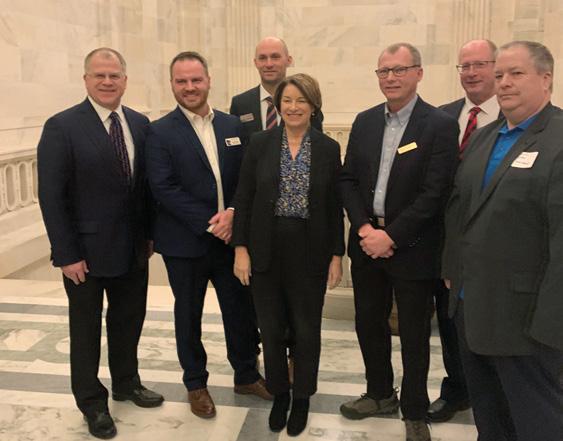
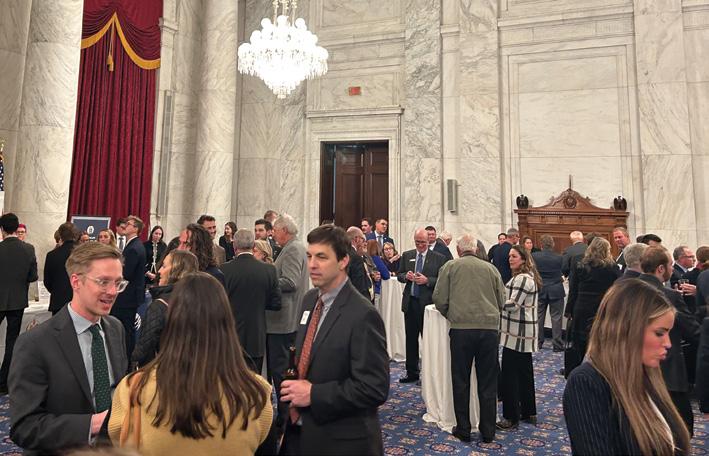
“Wheat 101 invites legislators to experience the entire wheat value chain, from growers to millers to end-product manufacturers.”
“We’ve been living on extensions now for several years,” Younggren said. “Our ARC and PLC programs are outdated. I think we’re about twelve years into when those programs started and we’re still using the same numbers and the same formulas.”
When it comes to conservation practices, NAWG opposes any efforts to expand conservation compliance but supports voluntary conservation programs that can be utilized to expand the adoption and maintenance of conservation practices.
“The conservation standard practices that are implemented might not work in one wheat producing region compared to another,” Westlin said. “It’s important that those remain voluntary, and incentive-based so that there’s a suite of options that can be afforded to growers and they can adopt the practices that work best for their operation.”
On the eve of the Capitol Hill Visits, the National Wheat Foundation hosts Wheat 101, an educational event meant to inform members of Congress and their staff about each component of the wheat value chain and their importance to the economy.
“Wheat 101 is intended to help members of Congress learn more about wheat’s unique role as a food crop,” Westlin said. “We bring in all segments of the wheat value chain into one room so attendees can get a broader understanding and scope of the work that goes into the wheat production system.”
For NAWG, it’s another opportunity to get in front of legislators, giving them a glimpse into the wheat world.
“It helps amplify NAWG’s messaging by bringing everybody into one room where they can meet directly with a lot of different growers,” Westlin said. “They might have had a little bit more time to reflect on the meetings that they might have had with those offices earlier in the day and give them the opportunity to develop those relationships further.”
As the end of the winter meeting season draws near and wheat farmers start readying their equipment for spring’s work, NAWG will continue working on grower’s behalf in Washington, D.C., and never underestimate the value of its 20 member states coming together to enact change.
“We work with our grower leaders to develop an agenda that adds value to the work we’re doing and also challenges our members to think and work from a different perspective,” Westlin said.

By Sydney Harris
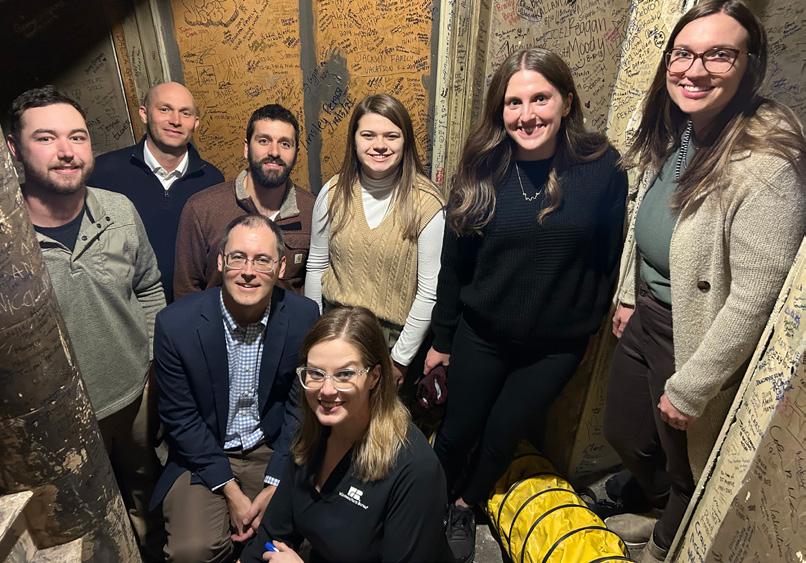
I’ve never thought of myself as a leader.
Yet, somehow, I wound up as a participant in the Ag Leadership Network (ALN), which is coordinated and sponsored by the Minnesota Association of Wheat Growers (MAWG), the Minnesota Wheat Research & Promotion Council (MWRPC) and Minnesota Farm Bureau. With a goal of increasing leadership and advocacy skills at the state and national level, I wasn’t convinced that I was a qualified candidate. But, as I quickly discovered, there isn’t a magic formula to being a good leader and there is a time and place for all personalities to shine in leadership.
“The Ag Leadership Network was created to introduce interested individuals to the world of agriculture leadership,” MAWG Executive Director Brian Sorenson said. “It can be daunting to jump headfirst into leadership roles so it’s a great opportunity for participants to learn about the variety of ways they can be a leader in the ag industry.”
Daunting, indeed.
With the entirety of the program, which kicked off in Sept. 2023, under my belt, it’s abundantly clear that the agriculture industry needs leaders. It also became apparent
that there are several ways to be an effective leader and, depending on the situation, different leadership styles are successful. Which is fortunate for me since I’ll never have the loudest voice in the room. Although my mom might disagree with that – I never hesitated to boisterously voice my opinion growing up. But wasn’t it my duty to give my parents a run for their money? In all seriousness, I’ve mellowed out since then and ALN showed me that my fellow participants and I each have a unique perspective and demeanor that have an important place in leadership.
The grand finale of the ALN program was a visit to the nation’s capital, Washington, D.C., Jan. 14-16, mere days before President Donald Trump’s inauguration. I’ve been lucky enough to have visited D.C. several times, but I’ve never seen it with that level of security. Let’s just say, it’s a bit more difficult to get where you need to be when there are barriers twice your height blocking every turn you take. Nevertheless, we persisted.
“It’s imperative that our state legislators (in D.C.) hear directly from the people that their policies affect,” Sorenson said. “That’s why Hill visits are a critical component of the
ALN program. We want the participants to gain firsthand experience meeting with legislators and having direct conversations with them, so they can be more prepared when they assume leadership roles in the future.”
Through my role as Communications Manager with Ag Management Solutions (the organization that assists in publishing Prairie Grains), I’ve sat in the background during several meetings with legislators, both at the state and national level.
And that’s the way I like it – I’m really not interested in saying something ridiculous in front of the people who decide our policies. Naturally, being on the other side was nerve wracking. Thankfully, during our Hill visits, I was teamed up with MAWG Director Erik Younggren and MWRPC Director Rhonda Larson, both pros at explaining how policies impact Minnesota producers to legislators who don’t understand farming.
“The first time you visit your legislators, or their staff, is really eye opening because you see that they’re real people,” said Younggren, who served as president of the National Association of Wheat Growers in 2012/2013. “And most of the staff are in their 20s or early 30s so they have a lot of the same cultural influences as the ALN participants –they’re truly peers.”
For a few of the ALN participants, it was their first time stepping foot in Washington, D.C., and they weren’t sure what to expect during Hill visits.
“I was nervous for the first meeting with legislators on the Hill,” said Kali Johnson, a fellow ALN participant, “but once we got into the meeting, I realized I had no reason to be nervous, especially being grouped with others who have visited before. I was surprised about how much the legislators cared about what we as individuals had to say.”
On our last morning, we ventured to the Canadian Embassy, where we met with Agriculture and Fisheries Counsellor Sonja Frohberg. Even though I grew up closer to Canada than Iowa, the sheer volume of trade between the two countries surprised me; the United States exports more to Canada than to China, Japan and the United Kingdom combined. And every $1 billion in U.S. agriculture and agrifood exports means 8,000 American jobs and $1.3 billion in U.S. economic activity.
Two years flew by, and even though I missed one of the sessions – nothing like ankle surgery to suck the fun out of summer – the program’s comprehensive look at Minnesota agriculture and ag policy was outstanding. It’ll still be a while (several years) before I start considering myself a leader, but ALN laid a solid foundation.
“I am grateful for my experience with the ALN program,” Johnson said. “Before ALN, I knew next to nothing about ag policy and now I know more than I could have imagined. After this program, I feel I have more confidence and knowledge to be a better leader in my community.”
Sydney Harris helps lead Prairie Grains as managing editor. Contact her at sharris@agmgmtsolutions.com
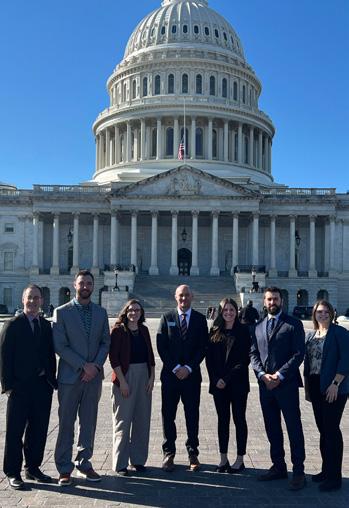
Sydney Harris, Georgetown
Peter Hvidsten, Stephen
Kali Johnson, Evansville
Kyle Jore, Thief River Falls
Tyler Nelson, Hinckley
Ben VonWahlde, Hawley
Kelly VonWahlde, Hawley
By Mark Askelson
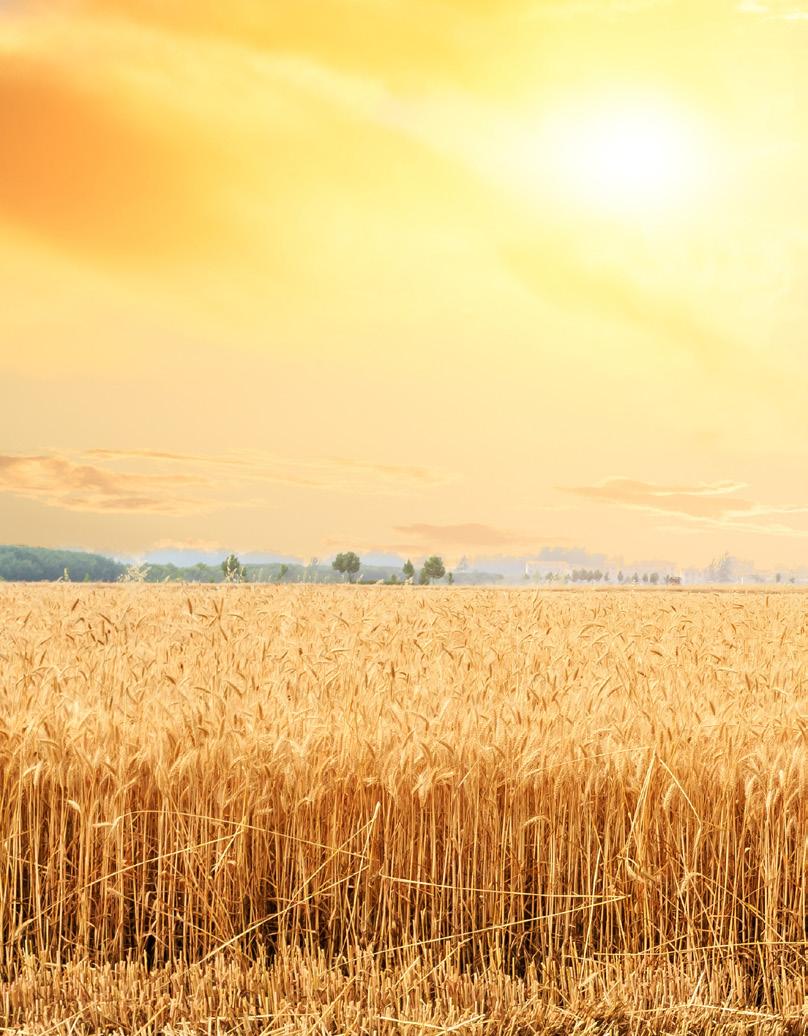
Kicking off the new year with a program packed full of new information, the annual Small Grains Update meetings made its way throughout northwest Minnesota in January, providing growers with updates on variety trials, research, crop marketing outlooks, legislative previews and more.
Providing information for wheat, soybean and corn growers, the Small Grains Update was sponsored in part by the Minnesota Association of Wheat Growers (MAWG), Minnesota Wheat Research & Promotion Council (MWRPC), Minnesota Soybean Research & Promotion Council, Minnesota Corn and University of Minnesota Extension.
Always a fan favorite during the Small Grains Update, Dr. Jim Anderson, University of Minnesota Spring Wheat Breeder, returned to the circuit to discuss results of the 2024 spring wheat variety trials (published in the NovemberDecember 2024 issue of Prairie Grains), make his top picks and preview some up-and-coming seed varieties that producers should keep an eye on.
Thanks to a survey distributed by MWRPC, Anderson was able to put together a list of the top planted spring wheat varieties in the state from the past few years. Leading the way in acreage was WB9590, followed by University of Minnesota
varieties MN-Rothsay and MN-Torgy, which Anderson says was due in part to their well-rounded nature.
“The more popular varieties are going to be more middle of the pack as it pertains to yield, but you of course have to look at other characteristics such as test weight, protein, straw strength and disease resistance,” Anderson said.
According to after harvest data, high yielders in 2024 included LCS Trigger and LCS Buster, but Anderson also reported the two varieties scored at the bottom for protein and baking quality. Another high scorer in the yield category this year was newcomer ND Stampede.
“It’s at the top for yield; however, there are some other traits to be aware of, but I don’t think they’re going to be deal breakers,” Anderson said, “so I expect it to become a popular variety moving forward.”
Anderson also compared how varieties fared in a number of other categories, which included scab, bacterial leaf streak, tan spot/Septoria, stripe and stem rust, preharvest sprouting and test weight. Taking everything into consideration, Anderson provided his top picks that producers can trust the most for all-around performance. The top picks in order of best yielding included MN-Rothsay, SY Valda, SY 611 CL2, MN-Torgy, Driver, Dyna-Gro Ambush and LCS Cannon.
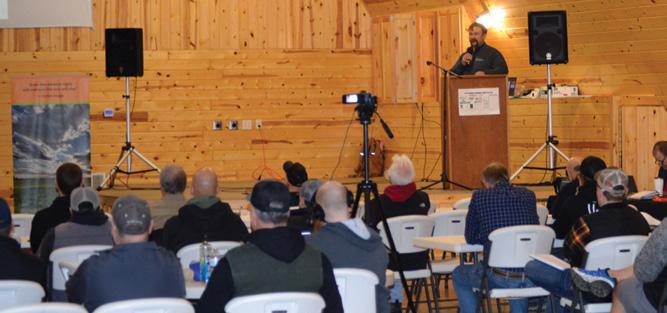
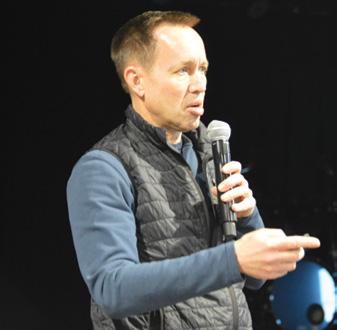
University of Minnesota’s Dr. Jim Anderson dug into the 2024 variety trials at the 2025 Small Grains Update meetings.
“MN-Rothsay is the second-most grown variety in the state for a reason,” Anderson said. “It’s a pretty good yielder, average protein, good straw strength, but its biggest weakness is that quality is borderline.”
As popular as the U of M’s MN-Rothsay has been the last few years, the University has a new spring wheat variety on schedule to be released in 2027 that could quickly become a new favorite. MN-21089-4 is only in its first year of testing, but Anderson says the results are significant enough to put it on track for future release.
“It yielded better than all our other varieties, but you still get decent protein, high test weight and it just all-around performed very well,” Anderson said. “If all goes well next year, we’ll start putting it into production for release in 2027.”
With uncertainty in the markets for corn, soybeans and wheat, Jim Emter, CEO of Van Ahn & Company, pitched to producers during the Small Grains Update how to market grain successfully even during bearish times.
“How can you make decisions if you don’t know where they need to be?” Emter said. “There’s a lot of information out there, there’s a lot of templates, you just need to pick one, and then once you have that you have to understand the markets.”
Emter also spotlighted current markets for corn, soybean and wheat and gave an outlook for what lies ahead in 2025. Much of the uncertainty that lies ahead, according to Emter, is how the Trump administration implements its agenda.
“Good, bad or indifferent, everything President Trump says or does will have an impact on the markets,” Emter said.
“The one consistency he’s had is that tariffs are going back in place and he’s going to be aggressive.”
Emter previewed several upcoming dates and key things to monitor that could impact markets, including the Feb. 27 USDA Outlook Forum, March 31 Grain Stocks and Planting Intentions report, South American weather, another potentially dry summer in the U.S. and the ongoing RussiaUkraine war.
As the host of the Small Grains Update, directors and staff from MAWG and MWRPC gave updates on priorities and projects. From a legislative standpoint, MAWG lobbyist Bruce Kleven aims to focus their priorities during the 2025 legislative session on maintaining the toolbox of crop protection products, work on environmental and sustainability regulations while continuing to build relationships with legislators through education of production agriculture.
“We have a lot of challenges here in Minnesota and crop protection is at the top of that list – for wheat specifically, we’ve been focused on chlorpyrifos and (ensuring) that use of that is maintained,” said MAWG Secretary/Treasurer Tate Petry, who presented at the update in Norman County. “Bruce does an excellent job at helping us keep those tools in the toolbox and making sure that if we have to intervene and visit with legislators that we’re down there to do that.”
On the checkoff side, MWRPC directors reported on their primary areas of focus for wheat research and promotion, with a big focus on market development, both internationally and domestically, through partnerships with U.S. Wheat Associates.
“Selling our hard red spring wheat can be a little bit of a hard sell because we have such a high-quality product, whereas the rest of the world may be less quality but their price is lower,” said Fertile farmer Kevin Leiser, who represents Area 2 on the Council and also serves as MAWG president. “We work with organizations such as Northern Crops Institute to showcase the value in that quality to buyers all over the world.”
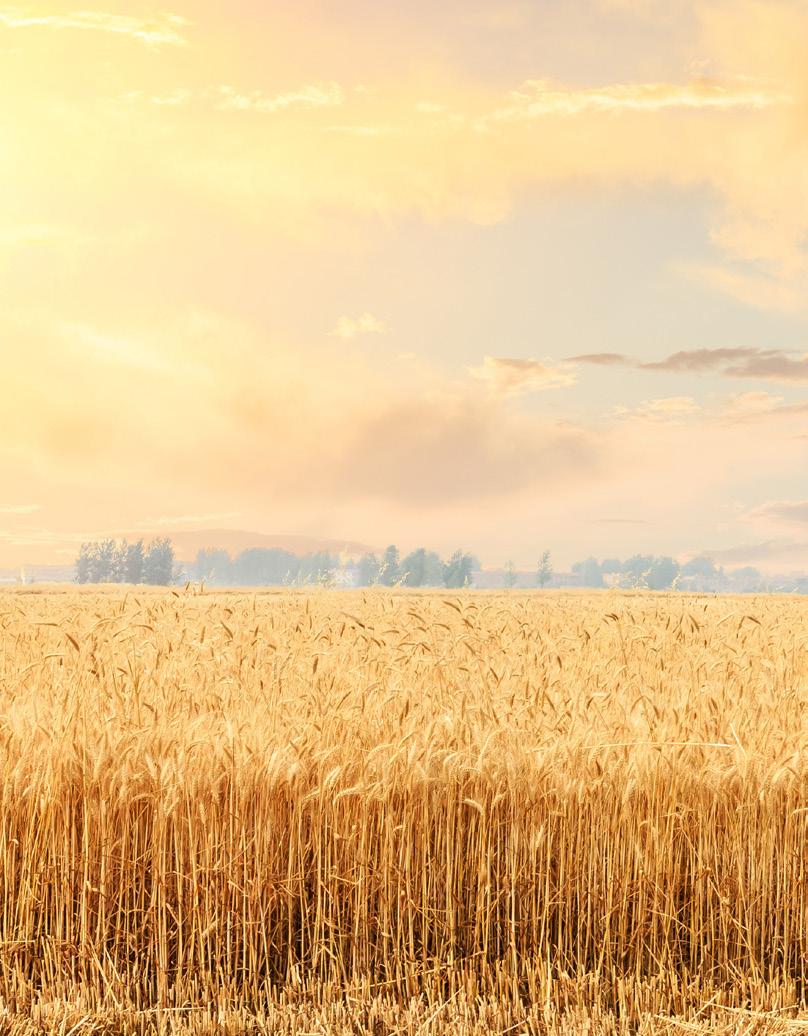
QR code:
When Corey Hanson first heard about the Minnesota Department of Agriculture’s (MDA) Water Quality Certification Program (MAWQCP) from fellow farmer Mike Skaug, he was a bit hesitant, but there’s a reason why Skaug felt that Hanson would be a good candidate to enroll in the program.
“Turns out, a lot of the practices under the program I was already doing, so there was no reason to be nervous,” said Hanson, who farms northwest of Gary in Norman County.
MAWQCP is a voluntary opportunity for farmers such as Hanson to take the lead in implementing conservation practices that protect Minnesota’s water. In return, producers receive regulatory certainty and are deemed in compliance with any new water quality rules. Farmers also receive recognition and priority for technical assistance for implementing practices that promote water quality.
As part of the enrollment process, Hanson worked with his Area Certification Specialist, Glen Kajewski of the East Polk Soil and Water Conservation District, to complete an assessment of his conservation practices and on-field verification. It was through that process Hanson learned he was already utilizing some of the qualifying conservation practices, including reduced tillage and nutrient management, but through the MAWQCP he was able to make tweaks and improvements and add additional practices as well, such as planting cover crops.
“I want to leave the soil in better shape than what I got it in, and if I’m good to the soil, it’ll be good to me,” Hanson said. “It hurts me in the wintertime when you see dirt piled up in the road ditches from wind erosion.”
Farmers in northwest Minnesota battle soil erosion from both the wind and water where the landscape is unobstructed and overland flooding is common in the spring. For those reasons, MDA hopes to see more producers in the region take advantage of the MAWQCP to protect soil health.
“The northwest corner of the state is a place where we at MDA would like to grow the MAWQCP,” MDA Commissioner Thom Petersen said during a January 2025 visit to Hanson’s farm. “I appreciate producers such as Corey Hanson and Mike Skaug, who are great leaders for agriculture and also see the importance of the program.”
The impact of MAWQCP isn’t just being noticed on the Hanson Farm or across the state; people have taken notice across the world. Through his involvement as a director on the Minnesota Soybean Research & Promotion Council, Hanson has had conversations with potential purchasers in Europe who appreciate his conservation practices.
“When I was in Netherlands this last year on a trade mission, they were well aware of our efforts to protect water quality,” he said. “It was good to have discussions with them and reassure them that our farmers care about the environment and being enrolled in this program allows me to do that.”
Since the program’s statewide launch a decade ago, 1,570 producers totaling over 1.14 million acres have been certified across Minnesota. Those farms have added nearly 3,000 new conservation practices. New practices are reducing greenhouse gas emissions by over 50,000 metric tons annually and have kept nearly 50,000 tons of sediment out of Minnesota rivers while saving 150,000 tons of soil and 62,000 pounds of phosphorous on farms each year.
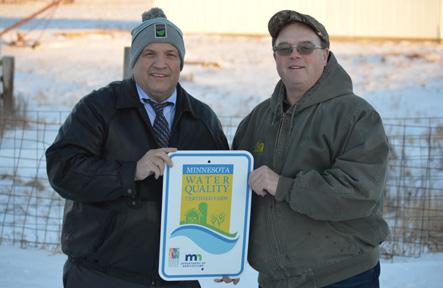
“A lot of the practices are common sense and are simple to do for preventing the soil from blowing around, and a lot of them are becoming more common practice for farmers anyways which is nice to see,” Hanson said. “We as farmers need to police ourselves and do what’s best for the environment because in the end that’s what’s best for us as well.”

After becoming certified, farmers receive a 10-year contract ensuring they will be considered in compliance with any new water quality laws, along with an official MAWQCP sign to display on their farm and other benefits. To be able to display the sign on his farm, which uniquely enough sits adjacent to some of the only land in the state to have never been tilled, is a proud achievement for Hanson.
“It shows appreciation for the work that I’m doing on my farm, and I’m proud to be able to show to others that I care for the land that I rely on to make a living,” Hanson said.
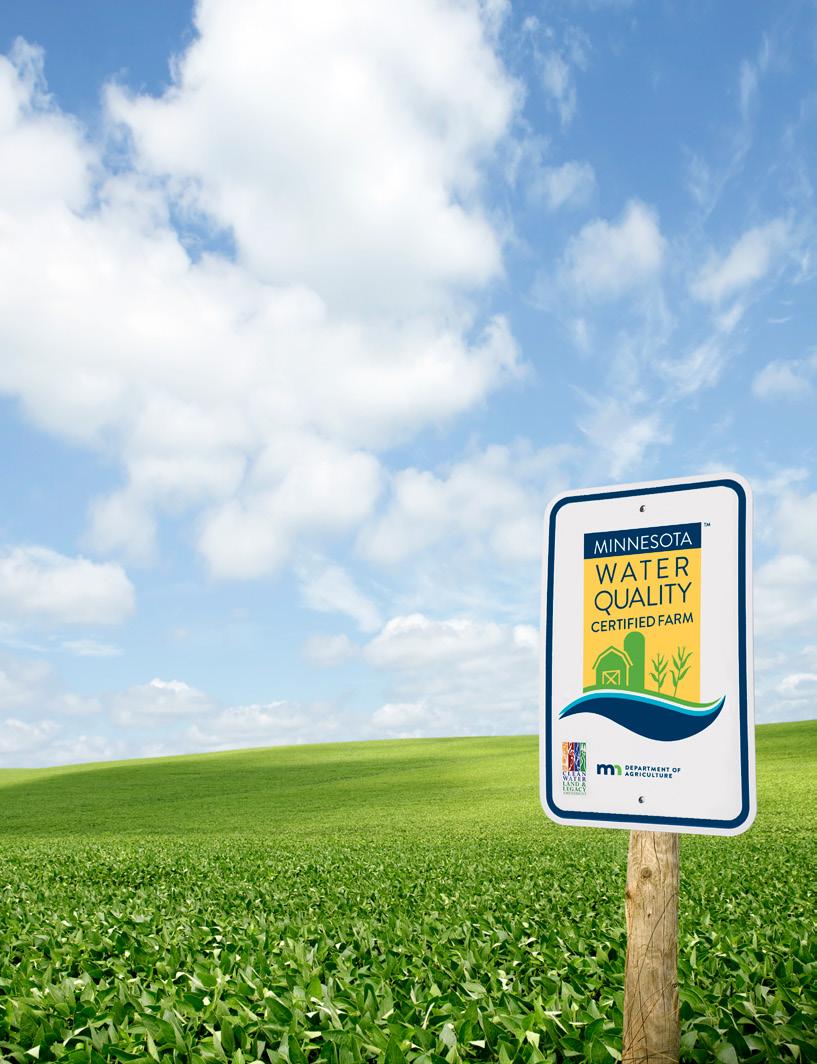

By Jochum Wiersma, University of Minnesota
The 2024 growing season: One to remember & forget

As I wrote in the introduction of the Variety Trials results in the November-December 2024 issue of Prairie Grains, the 2024 growing season was a wild, wet ride that was one to simultaneously remember and forget. The 2024 state average grain yield for hard red spring wheat (HRSW) was a record-breaking 68.5 bu/acre. Simultaneously, Fusarium head blight caused widespread problems in wheat, barley and even oats across the state. It was, however, a single rain event followed by three hot and humid days in mid-August that really left a sour taste in northwest Minnesota as the resulting sprout damage relegated an otherwise stellar crop to mere feed. Sprout damage can be detected visually (Photo 1). So-called blind sprout occurs when you see no sprout on the grain, but the dormancy of the seed has already been broken. Often the scutellum will enlarge when this happens, resulting in the embryo being slightly raised up from the seed. It is for this reason that elevators rely on the Hagberg Falling Numbers test (HFN) to test for sprout damage. The test doesn’t detect sprout but instead is a measure of the amount of α-amylase in the grain. Alphaamylase is an enzyme that hydrolyzes polysaccharides like starch into simple sugars (glucose and maltose). A low HFN test value indicates that there is a large amount of α-amylase present in the seed, resulting in a very rapid breakdown of the starch in the ground wheat sample used in the HFN test, thereby allowing the plunger to fall rapidly
through the slurry in the test tube.
At physiological maturity, the grain enters a phase of post-harvest dormancy. This high-temperature dormancy is an evolutionary adaptation to survive the summer heat in the desert and not germinate with the first few drops of moisture on the ground. Once harvested, the grain will slowly lose this post-harvest dormancy, especially when stored cool and dry. Unfortunately, repeated wetting and drying, while standing in the field or laying in the
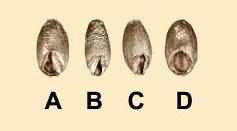

swath, will eventually result in a loss of this dormancy as well. Once the dormancy is broken, the seed is at risk of sprouting. Varieties differ in post-harvest dormancy. The University of Minnesota evaluates these differences in a dedicated trial using a misting chamber and assigns a preharvest sprouting (PHS) rating to all HRSW entered in the variety trials.
With this knowledge at hand, you can test grain yourself for sprout damage without using the HFN test. Select clean, undamaged kernels and count out 2 x 100 seeds from each field, lot or bin you’d like to test. Germinate the first 100 seeds now and score the percent germination after five and seven days. Next, you have two options. First you can simply store the second 100 seeds at room temperature for approx. 90 days and germinate them later this spring. Another approach is to use what is called ‘accelerated
aging’ followed by the germination test. Accelerated aging is achieved by subjecting the seed to approximately 106-degree heat and high relative humidity for 72 hours. The standard protocol details that a single layer of seed is placed on an elevated screen in a closed plastic container with 40 ml of distilled water at the bottom of the container. If the percent germination decreased after the accelerated aging or over time, the seed had already lost its dormancy and had some sprout damage. If the percent germination stays the same or improves, the lot likely did not have any sprout damage.
Jochum Wiersma is a small grains specialist at the University of Minnesota. Stationed at the Northwest Research & Outreach Center, Jochum can be reached at wiers002@umn.edu.
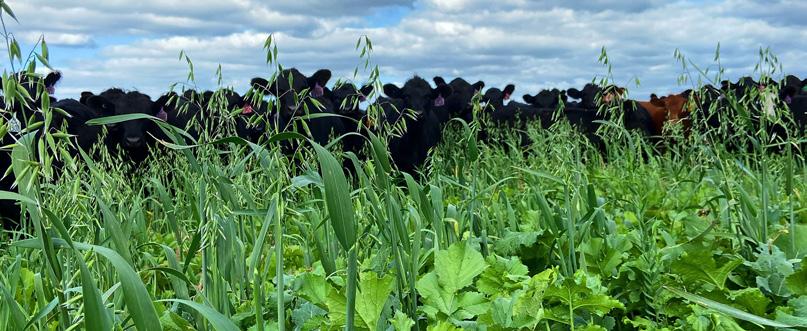
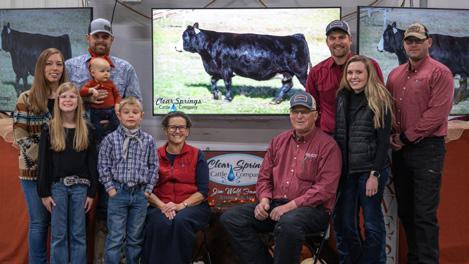
Clear Springs Cattle Co. has been using cover crops ever since Brady Wulf can remember. That’s because his father was planting them before Brady was even born.
First utilized as an opportunity to graze more cattle in the fall, cover crops are second nature to Brady, his parents and brother, who all work on the farm near Starbuck in west-central Minnesota. The cover crops started simple, with a single species planted after wheat harvest for another feed source for the farm’s Simmental and SimAngus cattle.
Now, multi-specie mixes are common on the wheat and corn acres, with turnip relatives like kale planted to improve drainage and aeration via their deep taproots and nutrition value for the cattle. And while some farmers might consider cover crops another expense, Wulf sees them as another tool to reduce inputs.
Wulf is one of three cover crop coaches for the Farmers for Soil Health program in Minnesota. In the role, he’s had on-farm visits with farmers to learn about their operations and share his experience with growing cover crops.
“One of the principles of soil health is context,” Wulf said. “I felt being a cover crop coach was a good opportunity to gather context, share my experiences with other farmers and continue to build my connections.”
Through the role, he has also helped sign up farmers for the Farmers for Soil Health program, which provides financial incentives to farmers starting to use cover crops for up to three years.
Wulf says he’s enjoyed the process and outcomes of using cover crops and other soil health practices, such as no-till.
“I think cover crops have made farming fun. There are always new challenges to improve the soil,” Wulf said. “It’s a bit boring with just the typical corn and soybeans.”
This material is based upon work supported by the U.S. Department of Agriculture, under agreement number NR233A 750004G003. Any opinions, findings, conclusions, or recommendations expressed in this publication are those of the author(s) and do not necessarily reflect the views of the U.S. Department of Agriculture. USDA is an equal opportunity provider, employer, and lender.
Learn more about Wulf’s fellow cover crop coaches in Minnesota, as well as the three South Dakota coaches.

Ryan Lee grows corn and soybeans with his brother near Fairfax, Minn. The pair began introducing cover crops into their farming operation in 2016 by interseeding corn at V6 and aerial seeding into soybeans in mid-August. They also seed cereal rye following corn harvest so they can plant soybeans green the following spring. Ryan says new practices need to make sense economically, and they have not seen a yield drag as a result of integrating cover crops. Three years ago, the Lee brothers switched to strip-till and are enjoying the savings in time and fuel from that new practice.

Myron Sylling farms about 1,600 acres in southeast Minnesota with his brother, Mikal. The farm, which the Sylling family has been operating for 132 years, was recognized as a Century Farm at the Houston County Fair in 2023. Having started no-tilling in the early 1990s, the brothers started integrating cover crops into their operation in 2013, and have aerial seeded, drilled and frost-seeded cover crops. Myron is a mentor with the Minnesota Soil Health Coalition and is on the Steering Committee for the Fields of Sinsinawa, a new farmer-led learning center.



Connect with a Cover Crop
Kody Aesoph farms and ranches with his in-laws south of Ree Heights, S.D., on a 100% no-till operation that has been integrating cover crops since 2018. He started learning about soil health and cover crops several years ago after realizing healthy soil was the key to fostering resilience in farming operations. A major part of the operation is cattle, so cover crops are used as feed and grazed multiple times throughout a growing season. By integrating cattle into the operation, Aesoph says they are improving nutrient cycling, which is a major part of rejuvenating the land.

Brothers Chet and Charlie Edinger farm together in Mt. Vernon, S.D., growing wheat, corn, soybeans and sunflowers. Before joining together in a formal partnership in 1998, Chet spent several years working in the banking industry while Charlie worked as an agronomist. Chet and Charlie advise on a wide range of cover crop topics, from rotations to nutrient management and chemical interactions to economics. Their “go-to” cover crop is a five-species brassica mix that they seed into wheat stubble in early August. They are strong proponents of controlled traffic and spent 20 years putting their system together so all equipment are 60-feet wide and set to 20-inch rows.

Alex Frasier farms with his dad, Jayme, in Faulkton, S.D. He currently works as an agronomist at Independent Ag and is passionate about cover crops, poly cropping and soil health. Four years ago, he implemented a poly cropping system planting rye, oats and flax as a companion crop between his soybean rows, letting them provide biological diversity for several weeks before terminating them. Soybean yields increased significantly each year as a result, but these companion crops have allowed them to reduce chemical and fertilizer inputs.
By Sydney Harris

Farmer-funded research is helping boost wheat’s demand
Where, oh where, are Minnesota wheat checkoff dollars?
Back in Minnesota wheat farmers’ pockets.
“When the Minnesota Wheat Research & Promotion Council (MWRPC) invests checkoff dollars into wheat research, producers reap the benefits,” said Brian Sorenson, MWRPC executive director. “Those dollars aren’t just going out into the ether. They’re funding research projects that directly impact wheat growers and increases their profitability.”

Tasked with directing Minnesota wheat checkoff dollars for promotion and research activities, MWRPC doesn’t take its job lightly. The Council has a rigorous process for eliminating and selecting research project proposals, which begins with a request for proposals (RFP), and are reviewed by the research committee.
“During the Prairie Grains Conference in December, we ask the researchers who submitted proposals to present their projects,” said MWRPC Treasurer Mikayla Tabert, who sits on the research committee. “The research committee is designed to vet projects for quality, such as cost versus benefit, and give a recommendation to the Council on which projects to fund.”
To foster robust discussion about each project, individuals with a variety of backgrounds sit on the research committee, including grower and industry representatives, crop consultants and MWRPC and Minnesota Association of Wheat Growers board members.
“It’s a benefit to have a variety of perspectives because it doesn’t always lead to the same conclusions,” said Tabert, who farms near Red Lake Falls. “I’m a farmer, so when projects get deep in the weeds and go beyond my understanding, it’s nice to have people on the committee who have more of a scientific-minded understanding of things. When you’re around people who sharpen each other, there’s absolutely a benefit.”
The research realm isn’t everyone’s cup of tea, but for Tabert, it’s key to encouraging other growers to branch out and experiment with various production practices.
“I really like research, and research is behind in our farming niche,” said Tabert, whose operation is a no-till, cover crop farm. “I wanted to be on the committee to help increase research in that area. There are a lot of farmers interested in more conservation approaches, but I understand the challenges that come with those, and though research often isn’t enough to convince them, it’s a first step; to convince growers to take that risk, there absolutely needs to be more research.”
One of the wheat checkoff research endeavor’s shining stars is the University
of Minnesota’s spring wheat breeding program, which is spearheaded by University of Minnesota Professor Jim Anderson. A tried-and-true checkoff investment, the breeding program has an established history of providing critical information to producers.
“Growers and agronomists across the region turn to the variety research Jim and his team publish each year to make important purchasing decisions,” Sorenson said. “We’re incredibly fortunate to have the program in our state.”
Variety research and selection isn’t the only aspect of growing wheat that is critical to profitability. Therefore, MWRPC also focuses on production and soil health research.
“When reviewing proposals, we ask ourselves, ‘How does this benefit wheat producers?’” Tabert said.
While it may not impact wheat farmers directly, research into cereal chemistry, such as spring wheat protein and baking quality and herbicide residues in harvested grain is a vital research priority for MWRPC.
“There are interesting research projects that don’t necessarily affect the farmer directly as far as considering wheat quality,” Tabert said.” It’s something that the wheat farmer might not think about the importance of, but we sell hard red spring wheat based on its quality. Obviously, research is important to help the farmer grow better but also to utilize the wheat better. In the United States, we’re very good at growing the pile of wheat but not necessarily at having the pile of wheat get used.”
At the end of the day, it’s a cycle – when Minnesota wheat growers are successful, MWRPC is successful, and vice versa.
“Wheat has been a tough crop for a lot of producers to grow profitably,” Tabert said. “So, putting those dollars into wheat to be able to make it a profitable crop is important, especially because it’s an important crop in the cropping system.”
• Spring wheat variety development
• Spring wheat production
• Environmental quality and soil health
• Cereal chemistry
To dive deeper into the research funded by MWRPC, check out Minnesota Wheat’s Research Review book, which is published yearly and features research reports of all wheat checkoff funded projects.
By Mark Askelson


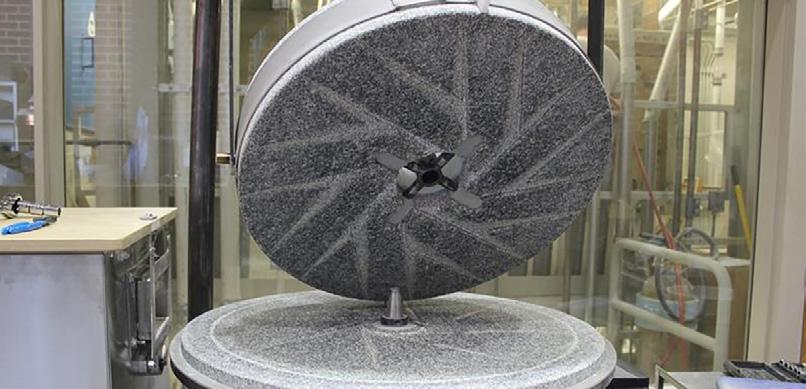
An ancient technology is coming out of the stone age and into the new age as consumers begin to understand the health benefits of whole grains through stone milling. The Northern Crops Institute (NCI) is helping educate and train future operators through a new course they began offering in 2024 that provides hands-on experience on how to operate a stone mill.
“Before we even designed this course, we spent one and a half years researching the stone milling process,” said Dr. Amrita Ray, NCI milling specialist. “We worked on a stone mill and different aspects that a local, smallscale baker or miller would want to better understand in their operations.”
The objective of the course is to better understand the mill, how to produce the flour desired, understand physical and chemical characterization, conditional requirements and methods and flour utilization in products.
“Everything we have learned during our extensive research on stone milling we are sharing with the participants,” Ray said. “In addition to the lectures, we go into the labs here at NCI and physically get to do and test the things we were discussing earlier in the day.”
The course is geared for custom millers, artisan bakers, food scientists


and farmers or producers thinking about adding value to what they grow. One such farmer is Brenda Chisholm of Chisholm Farm Trail in Gary, Minn., who took part in the course in summer 2024.
The Chisholms grow the traditional rotation of corn, soybeans, alfalfa and wheat on their farm, but also a variety of ancient grains including emmer, einkorn, millet, buckwheat, oats and rye. Looking for a way to diversify their farming operation, the Chisholms are in the process of setting up shop to process their wheat berries and sell them directly to consumers in the spring of 2025.
In addition to selling wheat berries, the Chisholms will be installing a stone mill to mill and sell their own flour from the crops they grow. They chose a stone mill over the more modern roller mill because of the additional nutritional properties that come along with the process.
“What we discovered is the nutrient value remains better intact if it’s stone milled because there’s less heat involved,” Chisholm said. “The bran, endosperm and germ all remain intact in stone milling as well, which provides a healthier, easier to digest product.”
However, the key difference that


has made roller milling the go-to method over stone milling is that the separation of the bran and germ from the endosperm allows the product to be more shelf-stable, whereas stone milled flour only lasts about a week unless kept in an air-tight container or frozen, according to Chisholm.
One of the biggest challenges for the Chisholm family in their unique operation is growing the grains that will eventually head to the stone mill. While they grow well in the region, there aren’t a lot of other producers growing them, which means less resources and farmers to lean on for experience.
“This part of the country is known for growing some of the best wheat varieties, but the problem is there aren’t a lot of people growing the ancient grains such as buckwheat or einkorn,” Chisholm said, “so there’s a bigger learning curve because there’s so few resources available.”
And while grains and the stone milling technology are ancient, the course came to life because of trending interest in whole grains as consumers shift their focus to better nutrition and less processed foods.
“It’s old technology that not everyone



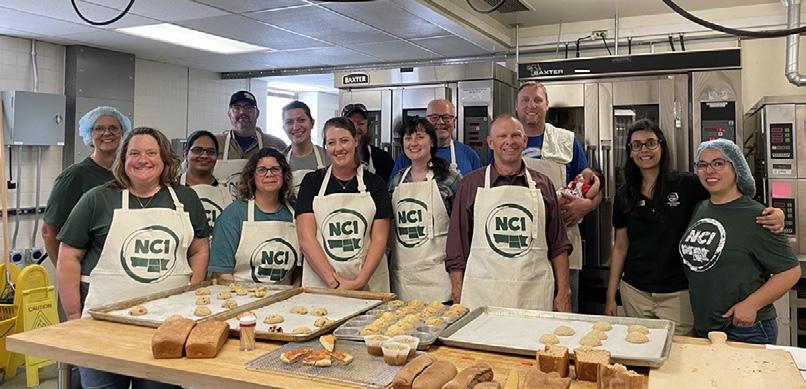
is aware of, so we had the opportunity to refine it and bring it back to life to help meet those consumer demands and health needs,” Ray said.
The first two stone milling courses that NCI offered last year averaged between 15-20 people with participants coming from across the country. The next course is planned for April 2025.
“The course itself was just fantastic because you can’t find that information and resources on stone milling just anywhere,” Chisholm said. “All of the


other participants in my course were saying how lucky we were to have this opportunity and have a resource like NCI in our backyard.”
Not only is interest growing in the stone milling course, but previous participants have reached out to NCI about their interest in an advanced course, which Ray says is possible in the future, especially as they upgrade to more advanced, automated stone milling equipment.

And as the stone milling process rises out of the stone age, Chisholm believes consumers will be better connected to the food they are eating and develop new markets for farmers, which is a win-win
“With more emphasis continuing to be placed on what we eat and what’s in our food, we’re seeing a rise in people’s interest in whole grains, and that’s going to support the stone milling industry and agriculture as a whole,” Chisholm said.
“When they pick up a bag of flour and it just says, ‘hard red spring wheat,’ that’s huge for people.”
For more information on NCI’s course, “Stone Milling: A Hands-on Experience,” or to order its Stone Milling Handbook, visit: www.northern-crops.com.
By Sydney Harris
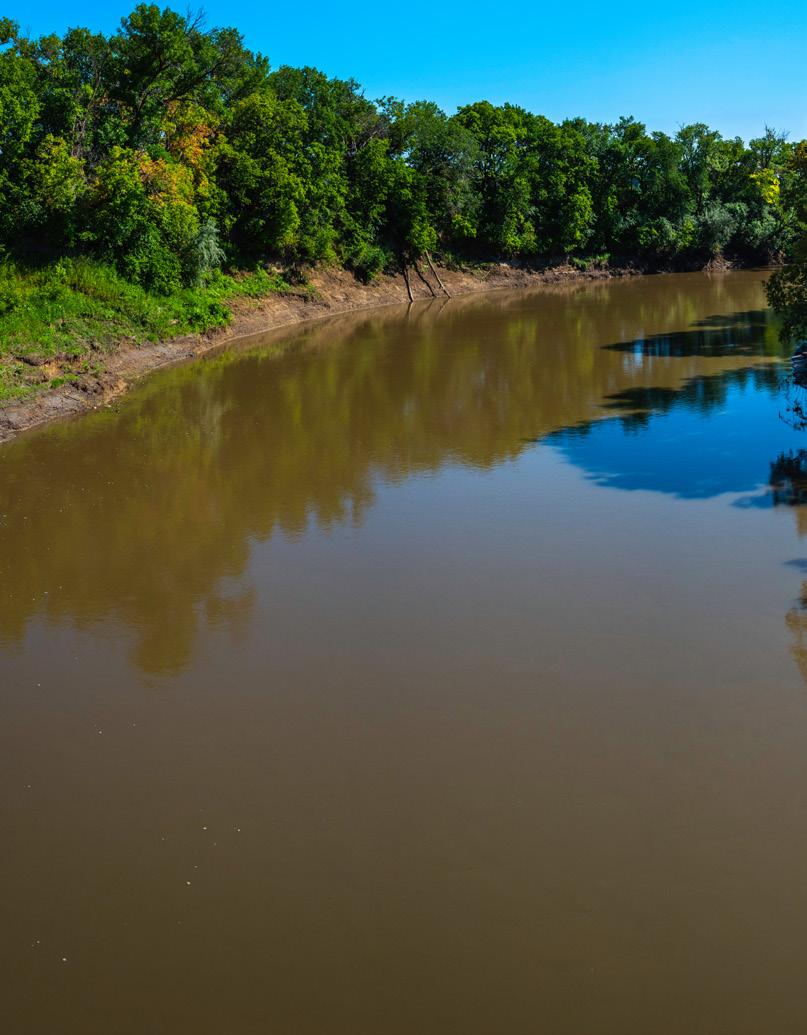
Thousands of years ago, an ancient glacial lake, “Lake Agassiz,” dominated northwest Minnesota. As the floodwaters receded, the result was thousands of acres of flat, fertile farmland that is now called the Red River Basin (RRB). However, the flatness of the RRB often results in frequent spring flooding. The last large-scale flood in the RRB occurred in the spring of 2022, with localized and short-term flooding in 2023.
To combat ongoing and frequent flowing, the Red River Watershed Management Board (RRWMB) was formed by the Minnesota Legislature in 1976 to provide a basin-wide perspective for water management, including flood control. Managed by a board comprised of representatives from seven-member watershed districts, the RRWMB historically dealt with the flooding problem within the Red River Basin with funding of flood impoundments and farmstead ring dike projects of its membership. Today, its mission has expanded to include water quality and habitat projects.
“We’re the voice for northwest Minnesota on water management, flood and natural resources issues,” said Robert Sip, RRWMB executive director. “As a regional entity, we’re able to work across state boundaries to reduce flood damages, increase water quality and enhance habitat in the RRB as a whole.”
For Minnesota wheat producers, having the RRWMB on their side offers an additional partner to handle water management concerns.
“The RRWMB and its member watershed districts play a vital role in our ability to operate,” said Tate Petry, secretary/treasurer of the Minnesota Association of Wheat Growers. “And because we have the RRWMB, we have an extra entity looking out for the best interests of the residents and its farmers and landowners.”
Since its inception nearly 50 years ago, the RRWMB has funded over 60 flood mitigation projects including impoundments, city flood protection, flood-prone property buyouts and over 300 farmstead ring dikes. There are 658 farmstead ring dikes in the RRB of Minnesota that were recently mapped.
“Almost every year, flooding is a hurdle that we have to jump over,” said Petry, who farms near Ada. “Flood management projects funded by the RRWMB have been a game changer in how quickly we are able to get in the field in the spring to plant our crops, not to mention allowing us to protect our homes.”
Flood management projects aren’t the only programs funded by the RRWMB that benefit farmers. In 2021, the RRWMB contracted with The Sanborn Mapping Company to collect Light Detection and Ranging (LiDAR) data for over 20,000 square miles in northwest Minnesota. LiDAR uses laser pulses to measure elevation/distances and to create 3D models of Earth’s surface.
“Now that we’ve captured elevation data, farmers and landowners can use it for drainage projects,” Sip said. “Over 60 billion data points were delivered, and the new data has an accuracy of approximately less than four inches. The old data only had an accuracy of about six inches.”
LiDAR data was paid for solely by the RRWMB, its members, counties and non-member watershed districts. No state or federal funds were included in this effort.
In other technical efforts, collecting streamflow data is critical to the RRB and the RRWMB and its membership have partnered with the United States Geological Survey
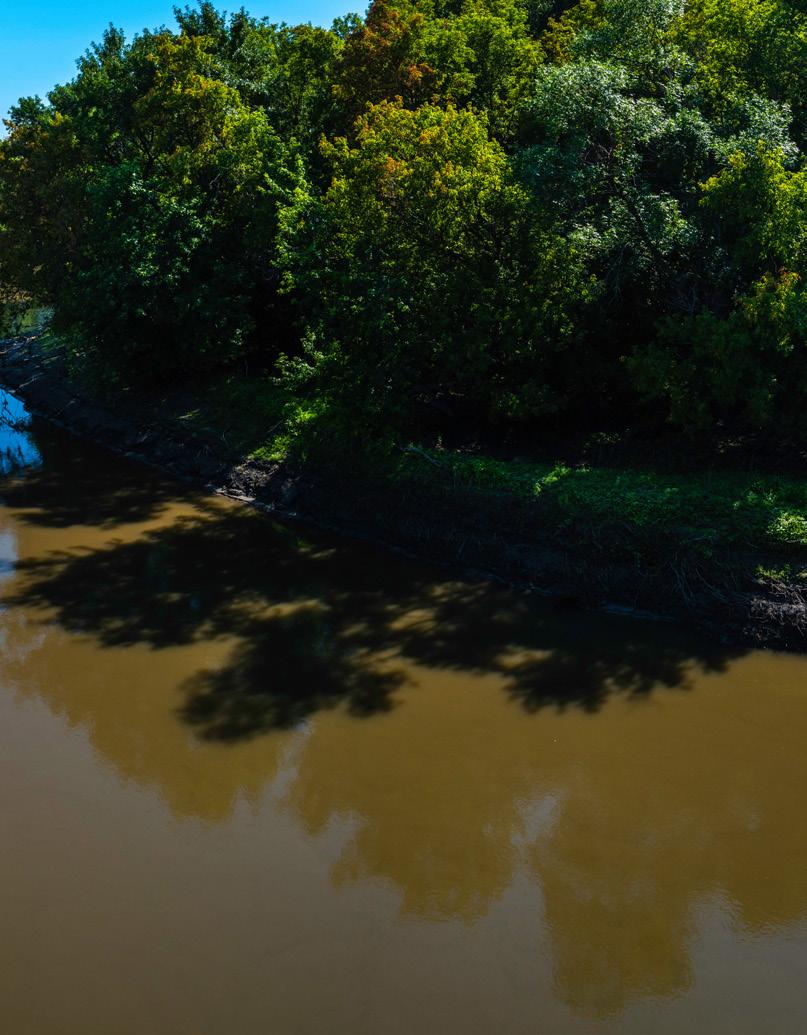
to obtain data for well over two decades.
“The information is critical to flood and emergency managers during times of flood,” Sip said.
Education is also a critical aspect of RRWMB’s mission, funding programs like the River Watch program and several other initiatives.
“We do a lot of partnering and collaborating throughout the Red River Basin region, including helping fund the River Watch program,” Sip said. “It’s an educational program for high school students to get them involved with water quality and natural resource issues.”
Advocating at the Capitol in St. Paul is another vital component of the RRWMB.
“We’re the voice of our members,” Sip said. “We have a full-time lobbying firm that works on behalf of our membership. Whenever a new law or rule is proposed that might affect our members, we have a collective voice. We’re a recognizable entity that’s able to increase and enhance our communication. This year, we’re looking for about $50 million from the state of Minnesota, if they have a bonding bill.”
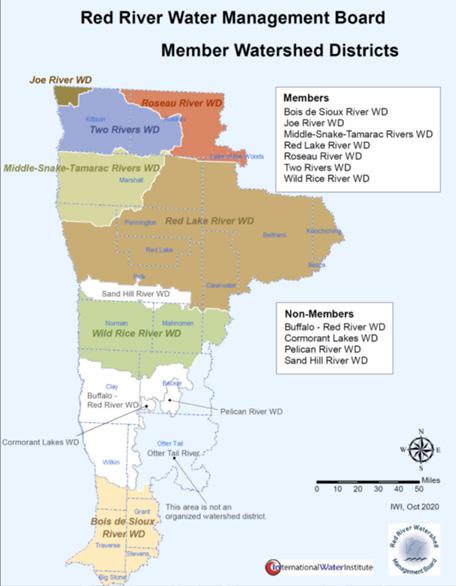

By Prairie Grains Magazine staff
The Minnesota Department of Agriculture’s (MDA) Rural Finance Authority (RFA) is now accepting applications for the 2025 Beginning Farmer Tax Credit, an annual program available to landlords and sellers (asset owners) who rent or sell farmland, equipment, livestock and other agricultural assets to beginning farmers. The Minnesota Association of Wheat Growers advocated for this credit to assist producers early in their careers.
Total funding available for the 2025 Beginning Farmer Tax Credit program is $4 million. The credits are funded on a first-come, first-served basis, so applicants are highly encouraged to apply early in the year before the stated deadlines.
Both the asset owners and beginning farmers must submit applications with lease and/or sale documents to be eligible for funding to hold their place in line. They may apply before sales close, if needed.
Asset owners can claim credits for one of the categories below in a given tax year for each beginning farmer they lease/sell to.
Full eligibility requirements and application materials can be found on MDA’s website. Questions may be directed to Jenny Heck at Jenny.Heck@state.mn.us or 651-201-6316.
During the 2024 Prairie Grains Conference in Grand Forks, N.D., Minnesota barley producers voted to terminate the barley checkoff in a 7-1 vote. MDA Commodity Council Coordinator Christina Iliev reported that the Barley Research and Promotion Council has until June to spend any remaining funds. MDA received a petition requesting to terminate the Council on Nov. 22, 2024, which was signed by more than 15 percent of Minnesota barley producers, equaling twelve producers. In 2024, 25,000 acres of barley were harvested in Minnesota, a 54 percent decline from 2023.
USDA announces more than $6 billion in clean energy investments
In the final weeks of the Biden administration, outgoing USDA Sec. Tom Vilsack announced more than $6 billion in clean energy investments through USDA’s Empowering Rural America (New ERA) and Powering Affordable Clean Energy (PACE) programs. Rural electric cooperatives and communities will use the funding to support thousands of jobs, lower electricity costs for businesses and families and reduce climate pollution by millions of tons each year. More than one in five rural Americans will benefit from clean energy investments
supported through New ERA and PACE programs.
“In just two years, the New ERA and PACE programs have created dozens of new partnerships with rural electric cooperatives and communities that will reduce pollution, create jobs and make clean energy more affordable for millions of rural Americans,” Sec. Vilsack said. “These investments we’re making today will continue to support the health, prosperity and wellbeing of rural Americans for generations to come.”
USDA is providing more than $5.49 billion in grants and loans to finance 28 clean energy projects in Minnesota, North Dakota, Alabama, Alaska, Arizona, Colorado, Georgia, Idaho, Kansas, Kentucky, Louisiana, Maine, Mississippi, New Mexico, North Carolina, Ohio, South Carolina, Tennessee, Virginia, Washington and Wisconsin.
USDA has now awarded roughly 90 percent of total available New ERA funding to benefit rural electric cooperatives and their members, obligating approximately $9 billion of the program’s $9.7 billion budget authority. This represents more than $14.5 billion in grants and loans benefiting 35 states, with
purchase more than 13 gigawatts of clean energy. These projects will create good-paying jobs, lower energy costs for rural communities,significantly reduce pollution and enhance the resiliency of the nation’s electric grid.
Falling number rapid test to be available in early 2025
EnviroLogix, a company based in Portland, Maryland, has created a rapid test to measure starch damage in wheat, which is expected to be commercially available in the first quarter of 2025. The TotalTarget for Sprout Damage rapid test will provide the grain industry with an alternative and complementary test to the falling number machine. The test directly measures the activity of amylase enzyme found in sprout damaged wheat. Currently, the test is only directed towards soft wheat.
For over 25 years, EnviroLogix has been a pioneer in GMO and mycotoxin testing that defines the nature of today’s agricultural supply chain. That legacy continues today with the addition of allergen testing and certified lab services. EnviroLogix’s passionate commitment to research and development continues to drive the next
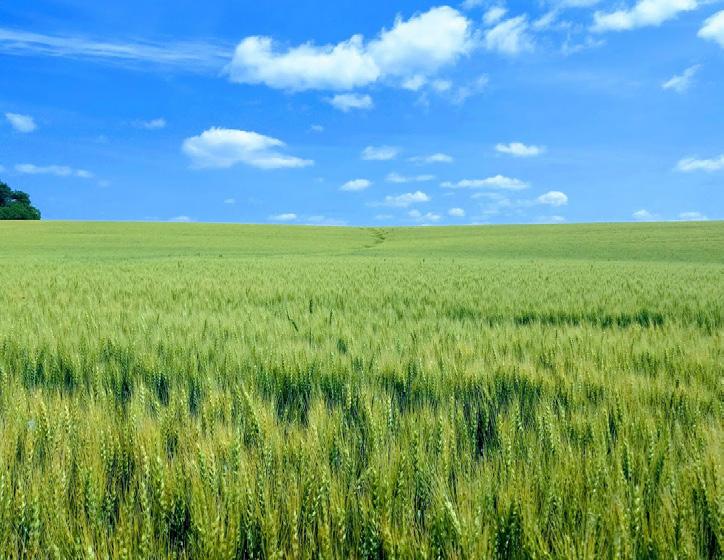
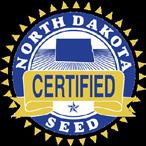




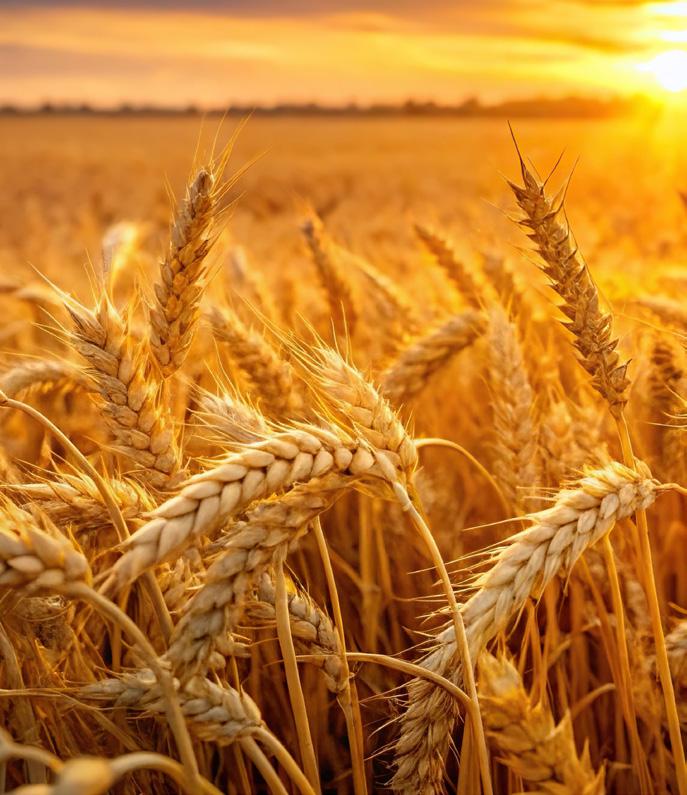
While farmers farm, MAWG is in St. Paul and Washington, D.C., protecting producers from harmful policies and advocating for farm-friendly legislation.